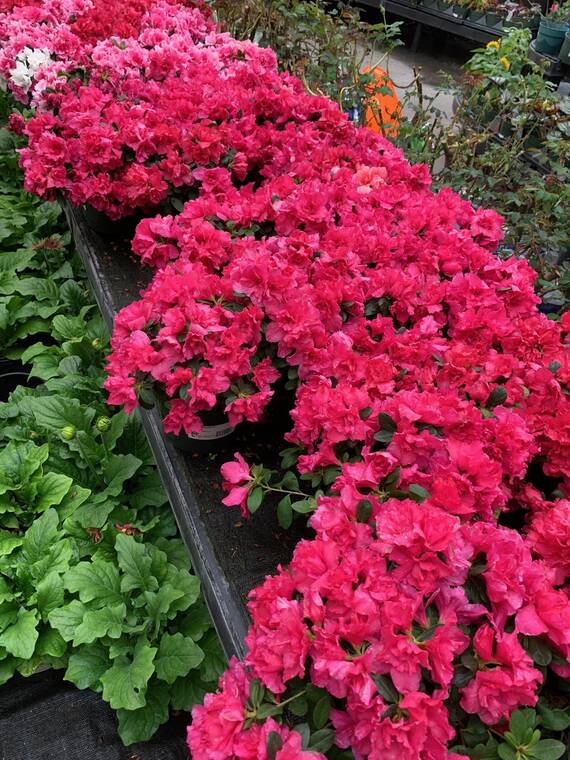Azaleas and vireya rhododendron available at some nurseries now
Spring will soon be here as days get longer and some azaleas are showing up at a few nurseries. These are the varieties that are grown in mainland gardens where temperatures are mild, especially in the Southeast and Pacific Northwest.
Another group in the same family may also be found here, but you must have connections to find them. Tropical Asia is well known for its spectacular rainforests loaded with many species of palms but it is easy to miss the tropical Vireya Rhododendrons growing as epiphytes high in the tops of gigantic trees. Most folks spend their time looking at terrestrial plants, or avoiding snakes and other jungle critters but look up and you will be elated.
Throughout the Northwest, Southeast and Japan, one of the highlights of spring is the mass blooming of azaleas and rhododendrons. In Hawaii, these attractive garden shrubs are popular in cool, moist areas. In the spring, the plants are available as potted houseplants at our local garden shops and nurseries. Now Vireya Rhododendrons are becoming available throughout the year as more nurseries and gardeners are becoming aware of them.
If you’re not quite sure about the tropical Rhododendrons and how to grow them, then get acquainted with the experts at the local educational meetings of Hawaii Chapter of the Rhododendron Society. For more information on meeting locations and other details call Sherla Bertelmann at (808) 966-9225.
Vireyas are a part of a small but widely distributed family found in many parts of tropical Asia. They usually grow in cool, moist regions like Malaysia, Indonesia and the Himalayas. Many are adapted to warm and moist temperate regions, Some have found Hawaii a good place to live, especially in East Hawaii. Here they may be grown in organic cinder and soil mixes but if the conditions are just right, they may grow on rocks or as epiphytes along with orchids, ferns and bromeliads.
Some species and varieties you will find on the market bloom in brilliant reds, whites, pinks, salmons and even mixes of white-pink and white-red.
Typical azaleas are slow to moderate growing in Hawaii. A good specimen six to eight inches high takes at least two years to reach their prime flowering. They are not easily grown from cuttings. That is why a gift of an azalea is something special. On the other hand many Vireyas may be easily grown from cuttings and can become large shrubs or small trees. This family of flowering plants is extremely variable, but have certain characteristics in common.
When you buy a potted Vireya living bouquet, they are easy to care for if you follow a few simple rules.
If the leaves get heavy with dust or sooty mold, wash them off with water. This will discourage insect and mite buildup. The proper watering of plants is more important than giving them a bath. In general, plants require a thorough soaking at least once a week. In warmer temperatures, plants in containers may require more water. Applying too little moisture may allow the soil in the bottom of the container to dry out, causing the plant to wilt or die. On the other hand, keeping the plant roots soggy wet will also cause injury. Make sure the pot has sufficient drainage. When planted in the garden, they are much happier. Where rainfall is sufficient, they take almost no care.
Azaleas and Vireyas grow well at temperatures between 60 and 80 degrees. Therefore, protect the plants from being broiled alive by direct sun, hot or windy areas. In cool mauka areas, they may be placed in sun.
Like people, they like their food served at regular intervals. Special acid azalea fertilizers are available. The best suggestion of feeding is to follow the directions on the plant food container. Since they are slow growers, they should only need fertilizer once every two to three months.
Here are some tips on diagnosing plant troubles. Brown tips or burned margins may mean you’ve applied too much fertilizer, you’ve let the plant roots dry out, or you’ve let the plant become wind burned. Yellowing of leaves indicates over watering, poor drainage, or poor soil aeration. Small leaves suggest a tight or heavy soil mixture, lack of fertilizer, or not enough moisture. Weak growth or light green color on otherwise healthy foliage indicates too much light, lack of fertilizer, root-rot, or poor root systems. Yellowing, wilting, or soft growth means too much heat or root injury.
Remember, azaleas and Vireyas require an acid high organic soil. If you decide to plant them in the garden or repot them, give plants a mix high in peat moss. Make sure you don’t plant them in soils that are high in calcium. Avoid planting in concrete containers, near sidewalks or concrete foundations since these contain calcium and will cause nutrient deficiencies.
Also remember, they should not be planted near the ocean or in hot, dry or windy areas.
It is not always easy to find Vireya Rhododendrons at local garden shops and nurseries. The best bet is to get acquainted with folks in the local chapter of the American Rhododendron Society. You may check out their website at www.HawaiiVireyaARS.org for more helpful information.


